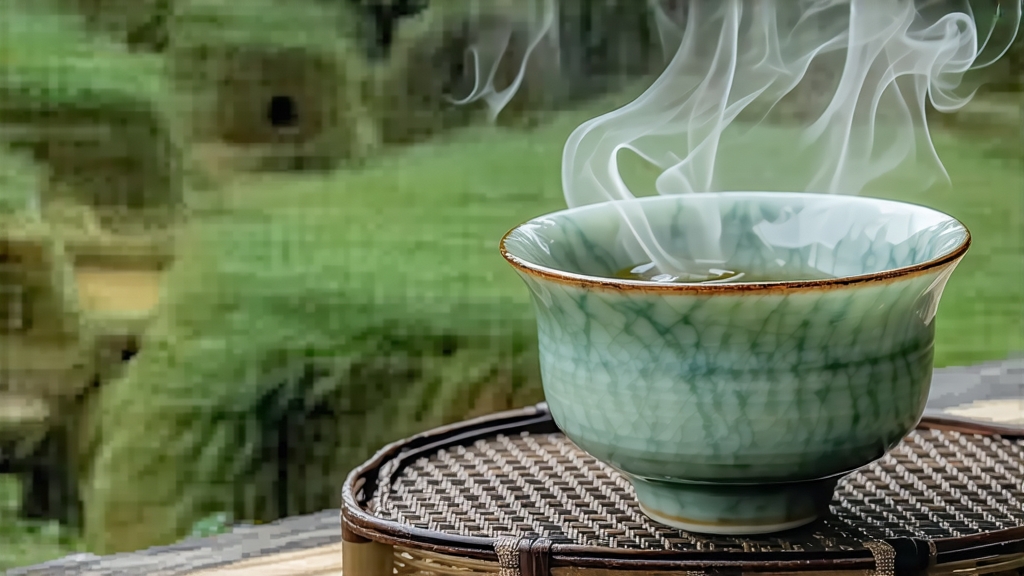
Hidden above the perpetual cloud belt that crowns the western rim of the Sichuan Basin, the Meng Ding massif has been sending spring-yellow buds to emperors for more than twelve centuries. Among the five officially recognised styles of Chinese yellow tea, Meng Ding Huang Ya—“the yellow bud from Meng Summit”—is the most elusive, the most fragrant, and the one whose manufacture still follows a protocol once monopolised by Buddhist monks and imperial inspectors. To understand why its liquor glows like late-afternoon sunlight and tastes of roasted chestnut, pine honey and mountain orchid, one must walk the narrow slate paths that zig-zag through bamboo groves at 1,400 m, listen to the bells of the ancient Ganlu Temple, and watch the mist roll back to reveal bushes whose leaves have been genetically shaped by altitude, shade and volcanic soil.
History: from imperial tribute to near extinction
The first written record appears in 808 CE, when the Tang court requested “ten jin of the tiny golden shoots from Meng Summit” as tribute. During the Song dynasty the quota rose to 500 jin, picked exclusively by tonsured monks who fasted for three days before plucking. When the Ming emperor abolished compressed tea in 1391, Meng Ding Huang Ya survived because it was already a loose-leaf souchong. By the late Qing it had become so scarce that the 1915 Panama-Pacific catalogue listed only 12 kg for export, all of it pre-sold to Russian aristocrats. The 1950s land-reform collectivised the gardens; farmers switched to higher-yield green tea, and the yellowing technique was almost lost. A single 78-year-old monk, Shi Guangde, secretly kept a handwritten scroll describing the “men huang” (sealed yellowing) step; in 1978 researchers from the Sichuan Tea Institute used it to resurrect the tea. Today 280 hectares are once again devoted to Huang Ya, but annual production remains below 3 000 kg, 70 % of which never leaves China.
Micro-terroir: why the bud turns golden
Meng Ding is a horseshoe-shaped ridge that traps moist monsoon clouds between the Tibetan Plateau and the Sichuan floodplain. Night temperatures drop 12 °C below daytime highs, forcing the bush (a local Camellia sinensis var. sinensis clone called “Ganlu #1”) to synthesise extra theanine and soluble sugars. The soil is a crumbly andisol derived from weathered trachyte; its high porosity drains excess water yet retains just enough mist to keep stomata open, concentrating aromatic volatiles. In early March, when the snow-line is still visible on Erlang Mountain, the bushes push out single, fat buds whose down already carries a faint chamomile scent. Only the bud and the first half-centimetre of the subtending leaf are taken; one kilogram of finished tea needs 42 000 such shoots, all plucked before 10 a.m. while the dew is still cool.
Craft: the art of “smothering” green into gold
Yellow tea is often described as green tea with an extra step, but that step—men huang—requires the reflexes of a sushi chef and the patience of a cheesemaker. Within thirty minutes of picking, the buds are spread on bamboo trays and wilted for 90 minutes at 28 °C to reduce moisture to 68 %. They are then pan-fired at 160 °C for four minutes, a process called “sha qing” that kills the leaf enzymes yet leaves the surface micro-structures intact. While still warm, the buds are wrapped in thick cotton cloth and placed inside a pine-lined wooden box. For the next 48 hours the tea master opens the bundle every 90 minutes to fluff and re-stack the leaves, allowing a non-enzymatic oxidation to occur in the presence of residual moisture and trapped carbon dioxide. The leaf slowly turns ochre, amino acids condense into pyrazines, and a mellow “cooked” aroma reminiscent of roasted sweet corn emerges. A final low-temperature bake at 65 °C for three hours fixes the colour and drops the moisture to 5 %. The finished bud is slim, needle-straight, and the colour of antique parchment; when rubbed between fingers it releases a scent that is simultaneously floral, nutty and faintly smoky.
Grades and styles
The state standard GB/T